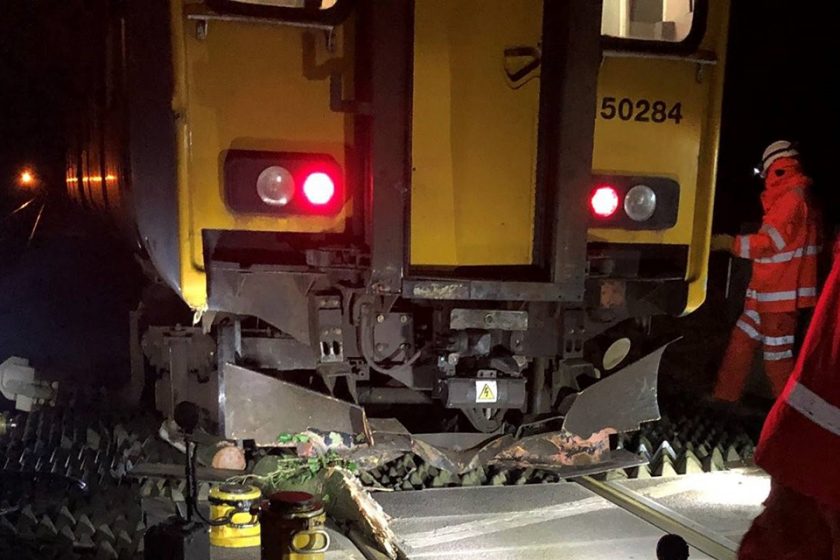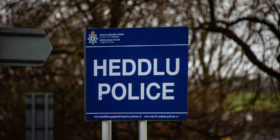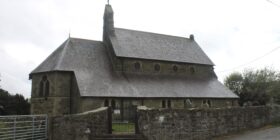Wrexham to Chester train Storm Arwen derailment report published by investigation branch

The Rail Accident Investigation Branch has published a report into a train derailment north of Wrexham during Storm Arwen.
At about 11:14 PM on Friday 26 November 2021, an empty passenger train collided with part of a fallen tree while travelling at 46 mph.
The incident occurred in Balderton, just north of Dodleston close to the Posthouse Roundabout of the A483/A55.
The train involved consisted of a class 150 diesel multiple unit which was being operated by Transport for Wales between Wrexham General and Chester.
The collision caused the leading axle of the train to derail. There were no injuries, but minor damage was caused to the train and to local signalling equipment.
An official report into the incident has been published, noting “Before this collision, train 5D77 had already collided with trees obstructing the railway on two other occasions after leaving Wrexham. All these collisions occurred while storm Arwen was causing high winds that affected much of the UK, including the intended route of the train.”
“The derailment occurred on the down Wrexham line, in a tree-covered cutting about 68 metres beyond the exit of Balderton tunnel. The tree that fell across the railway was an ash tree, with a trunk around 0.5 metres in diameter. This had been growing just beyond the crest of the cutting, about 9 metres from the railway track and about 0.5 metres outside the railway boundary fence.
“After the accident, Network Rail staff inspected the remains of the tree which caused the derailment and found that it had been in ‘apparent good health’ before it fell. This inspection concluded that the cause of the tree falling was ‘extremely high wind speeds’ coming from an unusual direction.”
Further detail is given of the Wrexham to Chester journey that evening:
At 22:12 hrs, train 5D77 departed from Wrexham General station. At 22:17 hrs, after it had travelled for 2.2 miles (3.5 km), it struck two trees close together at a speed of 38 mph (61 km/h). The driver called the signaller to report the incident, inspected the train (finding only superficial damage) and then removed those portions of the trees still obstructing the railway line. At 22:29 hrs he called the signaller stating that the train was able to proceed and was told by the signaller to ‘take time going down [the remainder of Gresford bank because] it wouldn’t surprise me if there weren’t a few more [trees] down.’
At Gresford bank the railway descends, in the direction of travel, at a gradient of 1:83 for a distance of about 4.1 miles (6.5 km), and the driver interpreted the signaller’s response as an instruction to proceed at caution. Proceeding at caution is described in module TW1 of GERT 8000, the railway Rule Book, as proceeding at a speed, taking account of conditions such as the distance the driver can see to be clear, that will allow the train to be stopped short of any obstruction.
At 22:30 hrs, train 5D77 continued on its journey, with the driver proceeding at caution. About a minute later, and after travelling a further 0.6 miles (1 km), it struck a third tree while travelling at 18 mph (30 km/h). At 22:34 hrs the driver called the signaller to report this collision. He then reversed the train to clear the obstruction, removed portions of the tree and inspected the train.
At 22:46 hrs the signaller reported the two collisions involving train 5D77 to Network Rail’s North West route control room, located in Manchester and responsible for managing infrastructure in north-west England. He also reported another weather-related accident about 0.3 miles (0.5 km) east of Chester station in which another train had collided with a metal shed blown onto the line.
At 22:54 hrs the driver of train 5D77 called the signaller again, having cleared the tree from the line and checked the train, and they came to a mutual understanding that the train should continue to proceed at caution until the bottom of Gresford bank. At 23:09 hrs, the train driver informed the signaller that he had reached the bottom of Gresford bank without incident. The driver then accelerated to maintain a speed of around 46 mph (74 km/h), which was less than the permitted line speed of 60 mph (97 km/h), until striking the tree shortly after exiting Balderton tunnel. This caused the leading axle of the train to derail.
The investigation documents what processes should be in place, and notes possible ‘blanket emergency speed restrictions’ as an option in the case of forecast or actual extreme weather conditions, “Before this derailment, North West route control staff were monitoring these events and had considered whether to apply BESRs. They decided against this, as they believed the incidents were mostly minor and manageable.”
The investigation findings explain that if an ‘extreme’ or multiple ‘adverse’ weather thresholds are exceeded, or forecast, relevant route control staff are required to convene an “extreme weather action teleconference (EWAT)” which gives a forum to co-ordinate weather-related responses from various parts of the rail industry and to provide a venue for ‘structured expert judgement’ where this is needed to support decision-making.
The report states, “The wind speeds expected for the day of the accident within the North West route escalated from ‘adverse’ to ‘extreme’ when the forecast was updated on the morning of the accident. Although NR/L2/OPS/021 required an EWAT to be convened in these circumstances, North West route control staff did not convene one because they believed that an EWAT held the previous day had sufficiently considered the weather-related risks. As an alternative, they instigated hourly monitoring of both forecast and observed weather conditions. Network Rail states that this did not show wind speeds breaching thresholds in those areas where the maximum permitted line speeds were greater than the emergency speed restrictions that would have been required by its procedures.”
The investigation also finds “it is unlikely that holding an EWAT would have prevented this accident” because the most likely mitigation would have been a 50 mph speed restriction and the train was travelling at less than that speed when the accident occurred.
The investigation branch said the accident demonstrates the importance of railway companies “considering all relevant meteorological parameters, including wind direction, when determining and applying weather-related risk mitigation” and “promptly adjusting mitigation measures required for safety of the line during extreme weather events, to take account of any incidents that have occurred due to the weather”.
Spotted something? Got a story? Send a Facebook Message | A direct message on Twitter | Email: [email protected]Latest News









